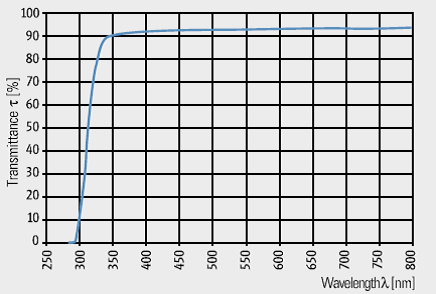Description
Schott D263M is a colorless borosilicate glass with a very low iron content. It meets requirements laid down in ISO 8255-1. It has high spectral transmission, excellent flatness and a refractive index finely adapted to microscopes. Very good resistance to chemical attack. Fire polished. |
Applications
The characteristics of this special composition substrate glass makes it suitable
for a variety of applications, including:
- Microscope cover glass
- Thin film substrate
- Touch control panels
- Solar cells
- Sensors
|
Mechanical Properties
| Density p in g/cm3 |
2.51 |
| Stress optical coefficient C in 1.02 · 10-12 m2/N |
3.4 |
| Young's Modulus E in kN/mm2 |
72.9 |
| Poisson number µ |
0.208 |
| Modulus of torsional shear G in kN/mm2 |
30.1 |
| Knoop hardness HK100 |
590 |
|
Electrical Properties
| Dielectric constant Ԑr at 1 MHz |
6.7 |
| Dielectrical loss factor tan δ at 1 MHz |
61·10-4 |
| Electrical volume resistance pD in Ω · cm at defined temperatures pD for alternating current 50 Hz |
| |
θ = 250°C |
1.6 · 108 |
| |
θ = 350°C |
3.5 · 106 |
|
Thermal Characteristics
| Viscosity and Temperature |
| Description |
Viscosity log Ƞ [dPas] |
Temperature θ [°C] |
| Strain point |
14.5 |
529 |
| Annealing point |
13.0 |
557 |
| Softening point |
7.6 |
736 |
|
| Transformation temperature in °C |
557 |
|
|
| Expansion factor α |
Coefficient of thermal expansion α (20-300°C) in 10-6 K-1
(static measurement) |
7.2 |
|
Spectral Transmittance (d=0.15mm)

|
Optical Properties of Schott D263M
Refractive indicies
ne (λ = 546.1nm): 1.5255 ±0.0015
nD (λ = 589.3nm): 1.5230
Above value ve: 55
The light transmittance for a thickness of 0.15 mm is TVD65 in %
(d=0.15mm) = 91.7 ± 0.3%. In the visible range of the spectrum D26 M is
without absorption. The excellent UV absorption properties make D263M
an ideal material for use in fluorescence microscopy.
Thickness* Dimension of Schott D263M
No. 0 = (0.08 - 0.12mm)
No. 1 = (0.13 -0.16mm)
No. 1.5 = (0.16 - 0.19mm)
No. 2 = (0.19 - 0.23mm)
*Not all thicknesses available in all sizes
|
Chemical Properties of Schott D263M
Hydrolytic resistance: (DIN ISO 719)
Hydrolytic class: HGB 1
Equivalient of alkali (Na2O) per gram of glass grains in µg/g: 20
Acid resistance (DIN 12 116)
Acid class: S 2
Half surface weight loss after 6 hours mg/dm2: 1.4
Alkali resistance: (DIN ISO 695)
Class: A 2
Surface weight loss after 3 hours mg/dm2: 88
|
Chemical Composition of Schott D263M
SiO2 = 64.1%
B2O3 = 8.4%
Al2O3= 4.2%
Na2O = 6.4%
K2O = 6.9%
MgO -
CaO -
BaO -
ZnO = 5.9%
TiO2 = 4.0%
As2O3 -
Sb2O3 = 0.1%
|